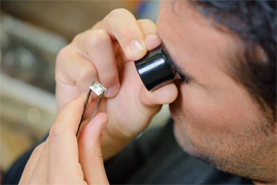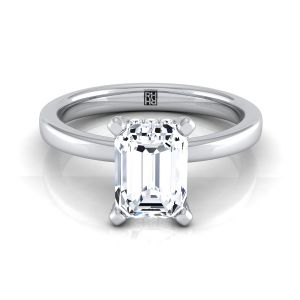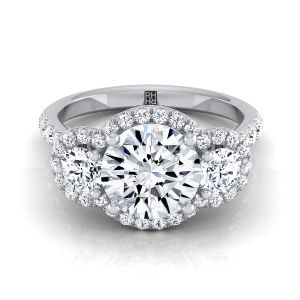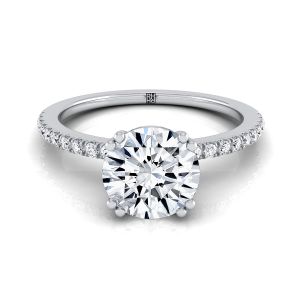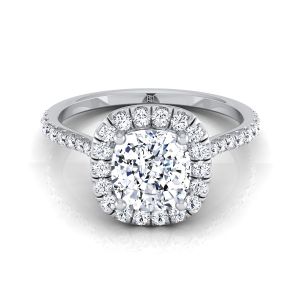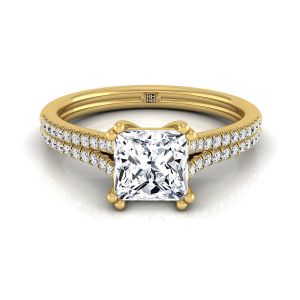
It is a known fact that many things factor in when it comes to 1 carat
diamond engagement ring price. People usually check
the 4 C’s to evaluate a
diamond’s value and cost, although inclusions also play a significant part in determining the overall price of the
stone.
To put it simply, inclusions are like the birthmarks given to a
diamond by nature during its formation. Normally, inclusions are not that visible to the naked eye in
diamond rings, but only a skilled
gemologist can identify that with the help of a 10x magnification loupe. Tagged as “clarity characteristics” by
diamond graders, these traits facilitate differentiating one
diamond from another as well as help in telling apart synthetic
diamonds from the natural ones. Below are 3 common types of inclusions in
diamonds you can see in the
gems and
jewelry segment.
 Cloud
Cloud – Cloud
diamond inclusion is a term that denotes a bunch of crystal marks in the
stone, which are located very close to one another.
Chip – Chip is a tiny, shallow opening on the
diamond surface, usually near the girdle of the
stone; this inclusion can happen due to accidental impacts too.
Cavity – Cavity
diamond inclusion is a deep opening in the surface of the
diamond, which usually occurs when an internal inclusion is breached during the polishing of the
stone.
Although minor inclusions in
diamonds might not be a reason to worry, it can sometimes affect the
diamonds’ appearance, especially when dirt and grime build up in the inclusions, and make them very much visible.
 It is a known fact that many things factor in when it comes to 1 carat diamond engagement ring price. People usually check the 4 C’s to evaluate a diamond’s value and cost, although inclusions also play a significant part in determining the overall price of the stone.
To put it simply, inclusions are like the birthmarks given to a diamond by nature during its formation. Normally, inclusions are not that visible to the naked eye in diamond rings, but only a skilled gemologist can identify that with the help of a 10x magnification loupe. Tagged as “clarity characteristics” by diamond graders, these traits facilitate differentiating one diamond from another as well as help in telling apart synthetic diamonds from the natural ones. Below are 3 common types of inclusions in diamonds you can see in the gems and jewelry segment.
It is a known fact that many things factor in when it comes to 1 carat diamond engagement ring price. People usually check the 4 C’s to evaluate a diamond’s value and cost, although inclusions also play a significant part in determining the overall price of the stone.
To put it simply, inclusions are like the birthmarks given to a diamond by nature during its formation. Normally, inclusions are not that visible to the naked eye in diamond rings, but only a skilled gemologist can identify that with the help of a 10x magnification loupe. Tagged as “clarity characteristics” by diamond graders, these traits facilitate differentiating one diamond from another as well as help in telling apart synthetic diamonds from the natural ones. Below are 3 common types of inclusions in diamonds you can see in the gems and jewelry segment.
 Cloud – Cloud diamond inclusion is a term that denotes a bunch of crystal marks in the stone, which are located very close to one another.
Chip – Chip is a tiny, shallow opening on the diamond surface, usually near the girdle of the stone; this inclusion can happen due to accidental impacts too.
Cavity – Cavity diamond inclusion is a deep opening in the surface of the diamond, which usually occurs when an internal inclusion is breached during the polishing of the stone.
Although minor inclusions in diamonds might not be a reason to worry, it can sometimes affect the diamonds’ appearance, especially when dirt and grime build up in the inclusions, and make them very much visible.
Cloud – Cloud diamond inclusion is a term that denotes a bunch of crystal marks in the stone, which are located very close to one another.
Chip – Chip is a tiny, shallow opening on the diamond surface, usually near the girdle of the stone; this inclusion can happen due to accidental impacts too.
Cavity – Cavity diamond inclusion is a deep opening in the surface of the diamond, which usually occurs when an internal inclusion is breached during the polishing of the stone.
Although minor inclusions in diamonds might not be a reason to worry, it can sometimes affect the diamonds’ appearance, especially when dirt and grime build up in the inclusions, and make them very much visible.









